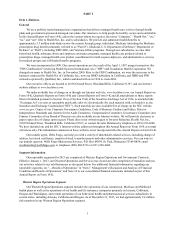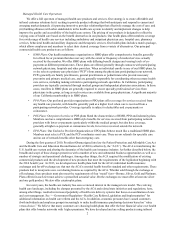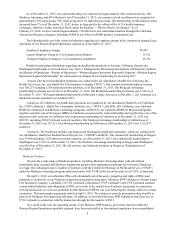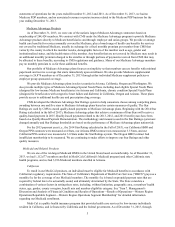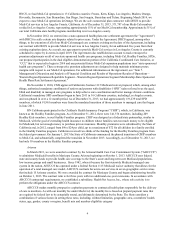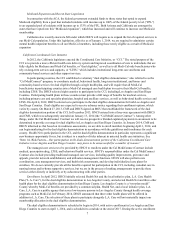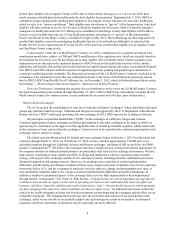Health Net 2013 Annual Report Download - page 9
Download and view the complete annual report
Please find page 9 of the 2013 Health Net annual report below. You can navigate through the pages in the report by either clicking on the pages listed below, or by using the keyword search tool below to find specific information within the annual report.7
Medicaid Expansion and Recent State Legislation
In connection with the ACA, the federal government extended funds to those states that opted to expand
Medicaid eligibility from a pool that included residents with incomes up to 100% of the federal poverty level (“FPL”)
to an expanded pool of residents with incomes up to 133% of the FPL. Both Arizona and California are amongst the
states that have opted into this “Medicaid expansion”, which has increased and will continue to increase our Medicaid
membership.
California also recently enacted a bill under which DHCS will require us to expand the list of required services to
our Medi-Cal population. Under this legislation, effective as of January 1, 2014, we are required to administer certain
mental health outpatient benefits to all our Medi-Cal members, including those newly eligible as a result of Medicaid
expansion
California Coordinated Care Initiative
In 2012, the California legislature enacted the Coordinated Care Initiative, or “CCI.” The stated purpose of the
CCI is to provide a more efficient health care delivery system and improved coordination of care to individuals that are
fully eligible for Medicare and Medi-Cal benefits, or "dual eligibles," as well as to all Medi-Cal only beneficiaries who
rely on long-term services and supports, or “LTSS,” which includes institutional long-term care and home and
community-based services and other support services.
In participating counties, the CCI established a voluntary “dual eligibles demonstration,” also referred to as the
“Cal MediConnect” program, to coordinate medical, behavioral health, long-term institutional, and home- and
community-based services for dual eligibles through a single health plan, and will require that all Medi-Cal
beneficiaries in participating counties join a Medi-Cal managed care health plan to receive their Medi-Cal benefits,
including LTSS. The DHCS selected eight counties to participate in the CCI, including Los Angeles and San Diego
Counties. Participating health plans in these counties must provide a full range of benefits for medical services,
including primary care and specialty physician, hospital and ancillary services, as well as behavioral health services and
LTSS. On April 4, 2012, DHCS selected us to participate in the dual eligibles demonstration for both Los Angeles and
San Diego Counties. Dual eligibles are expected to receive advance notice regarding their enrollment options, which
varies by county. On March 27, 2013, CMS and DHCS signed an MOU that established the framework of the dual
eligibles demonstration portion of the CCI. In December 2013, HNCS entered into a three-way agreement with DHCS
and CMS, which was subsequently amended on January 13, 2014 (the “Cal MediConnect Contract”). Among other
things, under the Cal MediConnect Contract we will receive prospective blended capitated payments in an amount to be
determined to provide coverage for dual eligibles in Los Angeles and San Diego Counties. In January 2014, CMS and
DHCS informed us that based on its readiness assessments, we are able to enroll members beginning April 1, 2014, and
can begin marketing for the dual eligibles demonstration in accordance with the guidelines and timeframes for each
county. Health Net’s participation in the CCI, and the dual eligibles demonstration in particular, represents a significant
new business opportunity for us, but is subject to a number of risks inherent in untested health care initiatives. See
“Item 1A. Risk Factors—Our participation in the duals demonstration portion of the California Coordinated Care
Initiative in Los Angeles and San Diego Counties may prove to be unsuccessful for a number of reasons.”
The managed care services to be provided by HNCS to enrollees under the Cal MediConnect Contract include
medical, prescription drug, LTSS, and behavioral health services. HNCS’s responsibilities under the Cal MediConnect
Contract also include providing traditional managed care services, including quality improvement, grievance and
appeals, provider network establishment, and utilization management functions. HNCS will also perform care
coordination, case management services, and health risk assessments, and develop individualized care plans for
enrollees. We do not currently provide all the benefits required for participation in the CCI, including custodial care in
nursing homes and in-home supportive services, but we are in the process of making arrangements to provide these
services either directly or indirectly or by subcontracting with other parties.
Enrollment. In April 2012, DHCS initially selected Health Net and the local initiative plan, L.A. Care Health
Plan (“L.A. Care”), for the dual eligibles demonstration in Los Angeles County, and selected Health Net and three other
health plans for the dual eligibles demonstration in San Diego County. Los Angeles County is a “two-plan model”
County whereby Medi-Cal benefits are provided by a commercial plan, Health Net, and a local initiative plan, L.A.
Care. L.A. Care is a public agency that serves low-income persons in Los Angeles County through health coverage
programs such as Medi-Cal. In February 2014, DHCS announced that three other health plans will be offered in
addition to L.A. Care. The selection of these plans to participate alongside L.A. Care will not materially impact our
membership allocation in the dual eligibles demonstration.
The dual eligibles demonstration is scheduled to begin in 2014, with active enrollment in Los Angeles and San
Diego Counties to start on April 1, 2014, and is scheduled to conclude at the end of 2017. During the active enrollment



